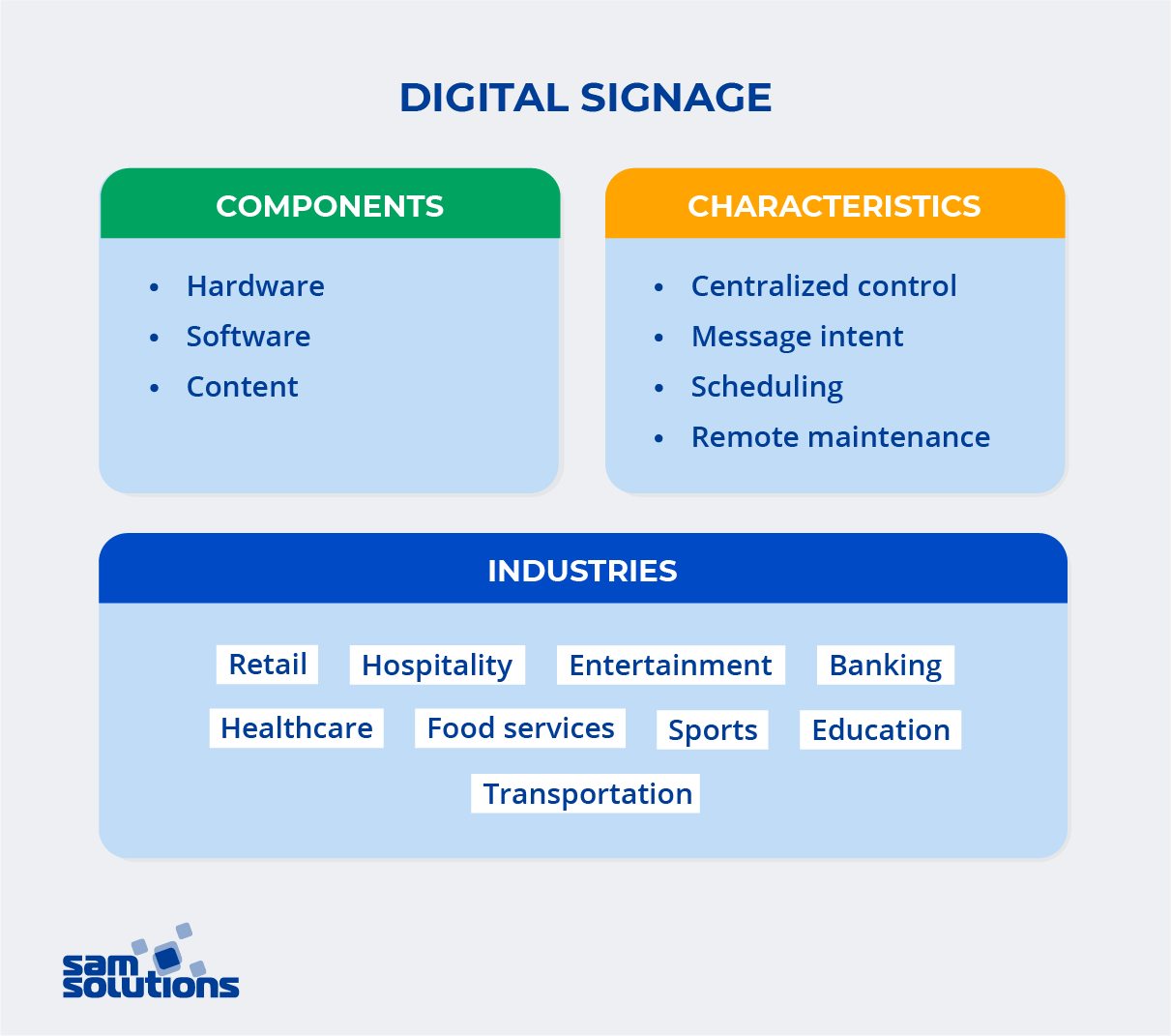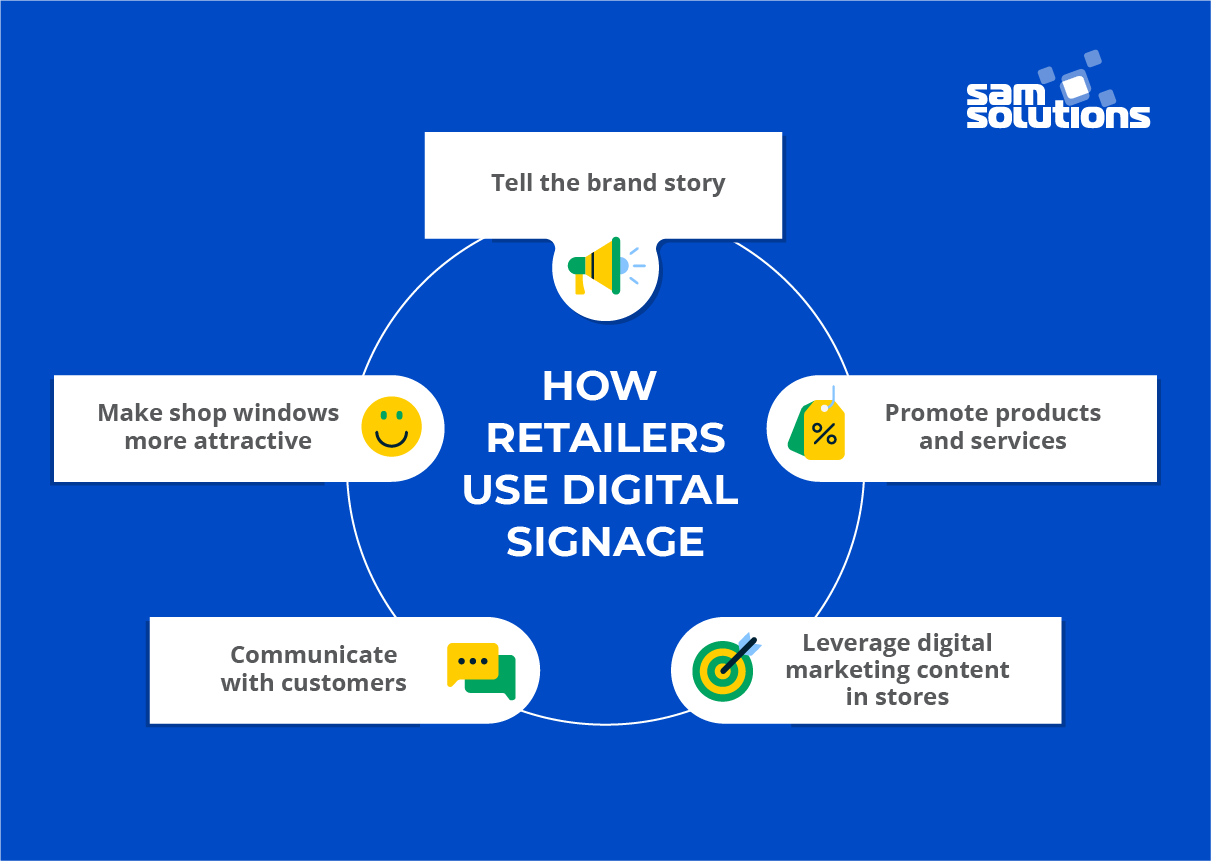Despite the significant increase in online shopping, traditional brick-and-mortar stores are not going to pass into oblivion. On the contrary, many physical stores attract more customers thanks to the introduction of smart digital technologies in their in-store processes. Digital signage is one of these cutting-edge technologies employed by retailers.
In this article, we explain why digital signage solutions are beneficial for retailers and how they can be used.
What Is Digital Signage?
First, let’s take a look at the definition of digital signage.

Digital signage is a technology used to present and distribute information to target audiences via various types of digital screens (video walls, LED screens, kiosks, etc.) installed in public places.
Key components
- Hardware — a range of devices used to demonstrate information and ensure interactivity with the audience (information kiosks, screens, etc.), with all their peripherals (cameras, scanners, etc.), mounting and connecting elements.
- Software — an operating system with drivers for hardware components; a user application for direct interaction with the audience; a content management system responsible for content creation, demonstration and updating.
- Content — pieces of information in various formats (text, audio, video, charts) aimed at attracting a customer’s attention and conveying a particular message.
Characteristics
- Centralized control — content is distributed from a single platform to multiple devices located in multiple places.
- Message intent — every piece of content has a specific objective: informative, entertaining, warning, etc.
- Scheduling — the content is regularly updated from a centralized platform.
- Remote maintenance — software and hardware issues can be detected and addressed remotely.
Industries
The digital signage market worldwide was estimated at $21.9 billion in 2021 and is forecast to reach $42.54 billion by 2030, which is a 7.7% compound annual growth rate, according to Precedence Research.
Today, digital signage solutions are commonly used for promotional and advertising purposes and to convey relevant information to employees and customers in the following industries:
- Retail
- Hospitality
- Entertainment
- Banking
- Healthcare
- Food services
- Sports
- Education
- Transportation
Now, let’s look in detail at how retailers use and benefit from digital signage.
How Retailers Use Digital Signage
Traditional printed signs still do their job in stores: they attract foot traffic from the outside, guide customers around the store and influence consumer behavior. However, they can’t offer as many opportunities as digital signs do.
Digital signage solutions actually do the same tasks, but at a wider scale and with better results. Let’s see how retailers use digital signage in physical stores.

1. Make Shop Windows More Attractive
In the world of physical retail stores, shop-windows play a crucial role in converting passers-by to customers. Used correctly, a store window is a powerful tool that sparks interest and convinces people to come inside and explore the product offering.
Retailers using digital signage screens create more engaging shop-windows compared to those who use printed signs and banners. The reason is that printed signs are static and a great deal of time and effort is required to update information on them. On the contrary, digital signage screens are dynamic and can easily catch the eye of passers-by.
Text scrolling signboards, video and audio content convey more information within a short time interval. Information in these formats is easy to digest and can quickly influence consumer behavior.
In addition, digital signage allows retailers to display only relevant content in their windows, since they can easily update or change it via a centralized software platform. For example, they can display discounts for specific products and change them every day.
2. Tell the Brand Story
People like exciting and fascinating business success stories. With traditional printed signage, retailers of the past had no opportunity to share their brand stories in public places. With retail digital signage, they are not limited by space or content formats.
An appealing video, an interview with the owners or partners, interactive infographics — any idea can be implemented and presented to the audience both inside and outside stores.
As you know, customers form an opinion about retailers not only based on the company’s products. They want to be aware of the brand identity, policy, goals and intentions; they want to hear its success story. By telling your story via digital signage screens, you make it memorable and engaging.
Such a connection with brands helps customers build loyalty and keeps them coming back to your store.
3. Promote Products and Services
Sales assistants in brick-and-mortar stores can answer any questions concerning product characteristics, usage, benefits, etc. However, the process is inefficient in large retail stores or hypermarkets: it’s physically impossible for human assistants to provide sufficient information to dozens of clients at a time. In addition, sales assistants may get bored answering the same questions again and again, which results in reduced motivation, missed details and reduced customer satisfaction.
Indoor interactive kiosks, tablets, or digital screens in stores can provide loads of useful information about goods on offer, including their physical parameters, configuration options, product comparison, video instructions and even testimonials by happy clients.
This way, retailers free up staff members for more important tasks and at the same time improve customer experience.
Another function that digital signage solutions can take over in retail stores is cross-selling and upselling. Using content management software with AI algorithms, marketers can create campaigns for promoting add-on items and products from related areas. For example, if a customer looks into buying a specific bicycle model, the program can also suggest options for pumps, locks, helmets, and other accessories.
In conclusion, you don’t need to have more sales assistants on the floor to increase sales.
4. Communicate with Customers
Digital signage is an efficient communication channel for keeping retail customers updated. Using digital screens, store owners can make announcements concerning the work of stores, company news, sales and discounts, current marketing trends and other urgent information.
In-store customer support can also be organized with retail digital signage solutions, which may include:
- answers to FAQs
- product catalogs
- wayfinding plans
- video manuals and case studies for products
- connection to a customer service specialist for additional assistance.
This type of virtual support makes the in-store buying process pleasant and seamless.
5. Leverage Digital Marketing Content in Stores
Many companies in the commerce industry today provide an omnichannel experience, allowing buyers to interact with them through different touchpoints. Hence, there is no need to strictly differentiate brick-and-mortar and online shopping experiences. On the contrary, digital marketing content can be efficiently used in physical retail stores with the help of digital signage.
For example, you can display the content from your social media channels, such as testimonial video or product presentations, on digital screens in your physical shops. This way, you’ll provide additional value for your in-store visitors and significantly enhance your marketing strategy.
What Are the Benefits of Digital Signage for Retail Stores?
Based on the above use cases of digital signage in retail shops, let’s take a look at the main benefits of such systems for retailers.
1. Increased Engagement of Your Retail Store Visitors
Digital signage is about dynamic content, and the human brain reacts more actively to visual effects than to static images. Retailers make use of this psychological peculiarity to grab the attention of passers-by and store visitors, thus making them more engaged with the brand.
One research project found that eight out of ten respondents visited a shop because the digital signage captured their attention. A fantastic level of engagement, right?
Moreover, you can place digital signs strategically around a store, such as the point of purchase or changing rooms, where they will have the highest impact on buyers.
Better customer engagement means more enjoyable shopping and, as a major benefit for retailers, increased sales.
2. Enhanced Social Media Presence
Digital presence is an integral part of any commerce business nowadays. The promotion of a company’s websites and social media channels has become one of the key tasks of retail digital signage.
On digital screens in stores, retailers display contact information for their social accounts and/or website, together with valuable or entertaining content from these.
This encourages store visitors to search for these pages on the internet and subscribe to them, and this is how retailers enhance their online audience. The number of potential buyers also grows, since social media is a strong tool for promoting products you sell, either online or offline.
As you can see, digital signage systems in brick-and-mortar retail stores are a link in the chain of increased online sales.
3. Improved Customer Experience
Due to digital signage, customers don’t get lost in physical retail stores and can get help even without human sales assistants nearby.
Digital screens provide all the needed information about products, special offerings and the company itself. They inform, recommend, navigate and entertain, evoking positive emotions and simplifying purchasing decisions.
4. Better Internal Communication
An important thing is that retail digital signage can focus not only on customers, but on store employees as well. Staff working environment in supermarkets, such as break rooms, kitchens, or store rooms, can be equipped with digital screens that convey employee-specific information:
- Personnel management issues
- Accident prevention regulations
- Scheduling
- Bonuses and discounts for employees
- Birthday and other milestone event messages
- Corporate announcements
This is a great opportunity to build up the corporate culture, effectively support internal communication and keep employees updated.
5. Brand Promotion Opportunities
Retail digital signage helps you make your company’s brand more recognizable, which is an obvious benefit. When shoppers regularly see appealing and vivid branded content in stores, they instinctively create a positive attitude toward your company. Hence, when they need to buy a product or service you offer, they may instinctively go to your shop but not the competitor’s.
Some Other Effective Ways to Monetize Your Digital Signage
There are also indirect ways to profit from retail digital signage.
- Partnership — offer your screens as an ad space to companies with related products or services for a fee. Just make sure that their ads are useful for your target audience.
- Educational messages — use digital signage to tell interesting facts and educate your customers. This way, you can influence their buying behavior and even change habits. For example, if your screens regularly broadcast facts about healthy food, customers will be more likely to buy such food in your stores.
- Enthusiastic clients — organize creative competitions and encourage your clients to participate for a certain prize, e.g., a gift certificate, in your store. The more people participate, the more brand awareness and revenue your store gets.
Content Ideas for Digital Signage at Retail Stores
The content that can be broadcast via screens is limited only to your imagination. Here are some tips:
- Product descriptions and reviews
- Discounts and sales
- Instructions
- Repurposed social media content
- User-generated content (photos, videos, reviews, comparisons)
- Brand story
- Interviews with managers, employees, clients
Introduce Digital Signage into Your Store
This article proves that digital signage systems provide new possibilities and improvements for retail stores. Customers enjoy a seamless in-store shopping experience merged with digital marketing features, while retailers benefit from increased sales and revenues.
If you are unsure about introducing digital signage solutions for your retail business, contact our specialists, who have relevant expertise and will consult you on all technical issues.



























 5 Reasons Why Your Business Needs a Mobile eCommerce Application
5 Reasons Why Your Business Needs a Mobile eCommerce Application Using Salesforce to Improve Your Sales Pipeline: Five Tips
Using Salesforce to Improve Your Sales Pipeline: Five Tips Cross-Platform Mobile Development: Five Best Frameworks
Cross-Platform Mobile Development: Five Best Frameworks How to Develop Custom Accounting Software
How to Develop Custom Accounting Software 10 Best Web Development Frameworks in 2024
10 Best Web Development Frameworks in 2024


![Digital Transformation Strategy [+ Key Trends in 2024]](https://www.sam-solutions.com/blog/wp-content/uploads/2020/07/main-Digital-Transformation-Strategy-min.png)








 Top 30 Ecommerce Tools to Elevate Your Business in 2024
Top 30 Ecommerce Tools to Elevate Your Business in 2024 5 Best Tools to Improve Embedded Software Testing
5 Best Tools to Improve Embedded Software Testing Why React and Node.js Are the Top Technologies for Creating High-Performance Web Apps in 2024
Why React and Node.js Are the Top Technologies for Creating High-Performance Web Apps in 2024 10 Best IoT Platforms for 2024
10 Best IoT Platforms for 2024
I agree with what you said about how digital signages make shop windows look more attractive to passersby since they help spark interest and convince people to come inside. I manage a resto-bar, and we serve specials that vary monthly, so I was thinking of having signage that we can easily change whenever we want. I’ll have to consider electronic message displays once I find a sign provider to contact for them soon.
Thank you for this comprehensive information on retail digital signage. I came to the conclusion that even one digital screen in a store can bring significant benefits and pay off quickly.
Dynamic and interactive digital signage connects buyers to your brand, creates a positive impression and keeps you ahead of the competition. The technology is worth investing in.
A “phygital” shopping environment is something that retailers create with the help of digital signage solutions installed in physical stores. The result is better customer experiences and increased revenues. What more could you want?
Digital signage is the future of retail because it merges the worlds of online and offline shopping, taking the best of both. Such an approach opens new opportunities for businesses and clients, so its popularity will grow.
It’s a great idea to tell the brand story via digital signage screens in physical stores. This way, a retail company can make buyers better understand the company’s vision of products or services it offers. It’s like to build a personal connection with each client.
With different types of digital screens and captivating content, retailers can create immersive environments in their stores that improve customer engagement and keep them coming back for more.
Retail digital signage is a huge and promising niche for software development companies. I’m sure that the development of content management software for digital screens located in stores will proliferate in the coming years.
Your article is very informative and clearly explains the benefits that retailers get from using digital signage solutions. The opportunities are really impressive.